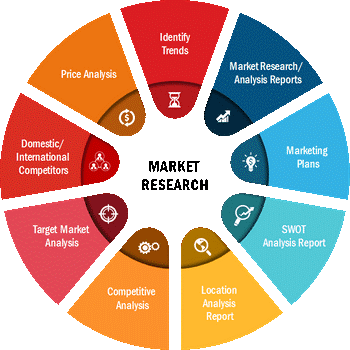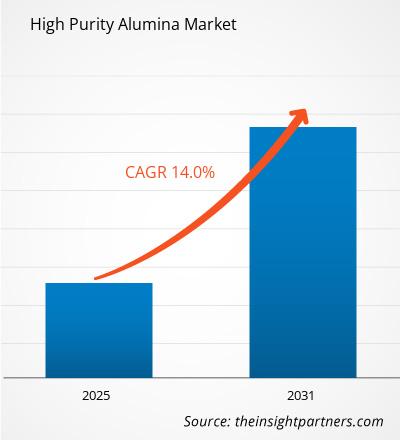高純度アルミナ市場は 2021 年に 21 億米ドルと評価され、 2022 年から 2031 年にかけて 15.1% の CAGR で成長します。
高純度アルミナ (HPA) は、高純度の酸化アルミニウム (Al2O3) であり、人工サファイアガラスや LED ライト用途に広く使用されています。 HPA は、複数の業界セグメントにわたって幅広い用途に使用できます。例えば、HPA はサファイア基板の製造における基礎原料として使用されます。電気自動車、光学レンズ、ナトリウムランプ、ハイブリッドカー、半導体、LED照明、リチウムイオン電池セパレーター、プラズマディスプレイスクリーン、スマートフォンやスマートフォン用の耐傷性サファイアガラスなど、幅広い製品の製造に使用されています。スマートウォッチなど。応用産業からの高い需要により、高純度アルミナの市場が拡大すると予想されます。予測期間中のアルミナ市場。
市場のダイナミクス
高純度アルミナ (HPA) は主に製造に使用されます。インゴットはサファイアベースの製品、半導体、LEDに利用されます。世界中でエネルギー効率の高い照明を促進するための政府のさまざまな取り組みにより、LED の生産が増加し、HPA 市場の大幅な成長につながりました。 LED 照明の世界市場は急速に成長すると予想されていますこれが HPA の需要を促進する重要な要因の 1 つです。さらに、電気自動車の需要の増加も HPA 市場を牽引する大きな要因です。
市場範囲
「世界的な高純度アルミナ」 「2031 年までの市場分析」は、世界市場の傾向分析に特に焦点を当てた、高純度アルミナ市場の専門的かつ詳細な調査です。このレポートは、製品および用途ごとに詳細な市場分割を行い、高純度アルミナ市場の概要を提供することを目的としています。世界の高純度アルミナ市場は、予測期間中に高い成長を遂げると予想されます。このレポートは、主要な市場プレーヤーの市場状況に関する重要な統計を提供し、高純度アルミナ市場の主要な傾向と機会を提供します。
戦略的洞察
市場の細分化
世界の高純度アルミナ市場は細分化されています製品とアプリケーションに基づいて。製品に基づいて、市場は4N、5N、6Nに分類されます。アプリケーションの観点から見ると、市場はLED、半導体、リチウムイオン電池、蛍光体、サファイアなどに分類されます。
このレポートは、定性的情報と定量的情報の両方を含む業界の詳細な概要を提供します。さまざまなセグメントに基づいた世界の高純度アルミナ市場の概要と予測を提供します。また、北米、ヨーロッパ、アジア太平洋 (APAC)、中東、およびアジア太平洋地域 (APAC) の 5 つの主要地域に関する 2021 年から 2031 年までの市場規模と予測推定も提供します。アフリカ (MEA)、および南アメリカ。各地域の高純度アルミナ市場は、その後、それぞれの国とセグメントにサブセグメント化されます。このレポートでは、世界 18 か国の分析と予測に加え、これらの地域で広まっている現在の傾向と機会も取り上げています。
地域的な観点から見ると、アジア太平洋地域が高純度アルミナ市場を支配し、2021 年の市場シェアは約 32% でした。アジア太平洋地域の優位性は主に、多数の高純度アルミナ メーカーの存在によるものです。エンドユーザーは日本、中国、オーストラリアにいます。主要企業は、韓国、日本、韓国にあるスマートフォン、リチウムイオン電池、LED のメーカーからの需要の増加に対応するため、この地域の生産能力拡大に取り組んでいます。
下の図は、世界の高純度アルミナ市場の収益成長傾向を示しています。
< p>このレポートは、高純度アルミナ市場に影響を与える両方の需要の要因を分析しています。供給側と市場のダイナミクス、つまり推進力、制約、機会、将来の傾向をさらに評価します。このレポートでは、ポーターの 5 つの力による徹底的な分析も提供し、これらの地域の高純度アルミナ市場に影響を与える要因を明らかにしています。
新型コロナウイルス感染症 (COVID-19) のパンデミックの影響
新型コロナウイルス感染症(COVID-19)の発生は、HPA に対する世界的な需要の減少を反映しており、これはエンドユーザーからの注文量が大幅に減少していることから明らかであり、その結果、生産量が減少しました。生産量の減少は、さまざまな HPA メーカーのビジネスに悪影響を及ぼしました。このため、新型コロナウイルス感染症拡大の初期段階では高純度アルミナの調達が減少し、世界の高純度アルミナ市場の成長に悪影響を及ぼしました。
需要の大幅な減少はサファイア業界で見られました。これは、北米、欧州、アジア、中東全体での半導体需要の大幅な減少によるものです。しかし、2021年の後半以降、半導体セクターは力強い成長を遂げており、この成長傾向は今後数年間続くと予想されています。これにより、高純度アルミナの調達が促進され、予測期間中の市場の成長が促進されるでしょう。
市場参加者
レポートの内容さまざまな有機および無機の成長戦略など、高純度アルミナ市場の主要な発展。さまざまな企業が、製品の発売、製品の承認、特許やイベントなどの有機的な成長戦略に焦点を当てています。市場で目撃された無機質な成長戦略は、買収、提携、そして企業の成長でした。コラボレーション。これらの活動により、市場関係者のビジネスと顧客ベースの拡大への道が開かれました。高純度アルミナ市場の市場関係者は、高純度アルミナの需要の高まりに伴い、将来的に有利な成長の機会があると予想されています。以下は、高純度アルミナ市場に携わる数社のリストです。
レポートには、SWOT分析と市場戦略とともに、主要な高純度アルミナ市場企業のプロフィールも含まれています。さらに、このレポートは、業界の主要企業に焦点を当て、企業概要、提供されるコンポーネントとサービス、過去 3 年間の財務情報、過去 5 年間の主な開発などの情報を提供します。
- 住友化学株式会社
- Altech Chemicals Ltd.
- Almatis, Inc.
- 日本軽金属ホールディングス株式会社
- バイコウスキー
- Polar Sapphire Ltd.
- Orbite Technologies Inc.
- 淄博宏和化学有限公司
- CoorsTek Inc.
- FYI Resources Limited
Insight Partner の専任の調査分析チームは、高度な統計専門知識を持つ経験豊富な専門家で構成されており、既存の調査にさまざまなカスタマイズ オプションを提供します。

- 過去2年間の分析、基準年、CAGRによる予測(7年間)
- PEST分析とSWOT分析
- 市場規模価値/数量 - 世界、地域、国
- 業界と競争環境
- Excel データセット


- Hydrocephalus Shunts Market
- Social Employee Recognition System Market
- Intraoperative Neuromonitoring Market
- Influenza Vaccines Market
- Dealer Management System Market
- Artificial Turf Market
- Procedure Trays Market
- Grant Management Software Market
- Biopharmaceutical Tubing Market
- Ceramic Injection Molding Market

Report Coverage
Revenue forecast, Company Analysis, Industry landscape, Growth factors, and Trends

Segment Covered
This text is related
to segments covered.

Regional Scope
North America, Europe, Asia Pacific, Middle East & Africa, South & Central America

Country Scope
This text is related
to country scope.
よくある質問
The report can be delivered in PDF/Word format, we can also share excel data sheet based on request
Based on geography, North America held the largest share of the high purity alumina market
The growing demand of high purity silica for LED and semiconductor industries are the major factors driving high purity alumina market
The technological advancement in the production and increased focus on sustainability is one of the major trend in the market
DuPont, ROCOL, ND Industries, Inc., Henkel, 3M, Threebond International, Inc., Whitmore Manufacturing LLC., SOUTH COAST PRODUCTS, LP, DOW, Hodgson Sealants are the key players operating in the high purity alumina market
The high purity alumina market is estimated to witness a CAGR of 14% from 2023 to 2031
Trends and growth analysis reports related to Chemicals and Materials : READ MORE..
The List of Companies
1. Alcoa Corporation
2. Altech Chemicals Ltd
3. Baikowski
4. HMR, Co., Ltd.
5. Nippon Light Metal Holdings Company, Ltd
6. Norsk Hydro ASA
7. Orbite Technologies, Inc.
8. Polar Sapphire Ltd.
9. United Company RUSAL Plc
10. Zibo Honghe Chemicals Co., Ltd.
The Insight Partners performs research in 4 major stages: Data Collection & Secondary Research, Primary Research, Data Analysis and Data Triangulation & Final Review.
- Data Collection and Secondary Research:
As a market research and consulting firm operating from a decade, we have published and advised several client across the globe. First step for any study will start with an assessment of currently available data and insights from existing reports. Further, historical and current market information is collected from Investor Presentations, Annual Reports, SEC Filings, etc., and other information related to company’s performance and market positioning are gathered from Paid Databases (Factiva, Hoovers, and Reuters) and various other publications available in public domain.
Several associations trade associates, technical forums, institutes, societies and organization are accessed to gain technical as well as market related insights through their publications such as research papers, blogs and press releases related to the studies are referred to get cues about the market. Further, white papers, journals, magazines, and other news articles published in last 3 years are scrutinized and analyzed to understand the current market trends.
- Primary Research:
The primarily interview analysis comprise of data obtained from industry participants interview and answers to survey questions gathered by in-house primary team.
For primary research, interviews are conducted with industry experts/CEOs/Marketing Managers/VPs/Subject Matter Experts from both demand and supply side to get a 360-degree view of the market. The primary team conducts several interviews based on the complexity of the markets to understand the various market trends and dynamics which makes research more credible and precise.
A typical research interview fulfils the following functions:
- Provides first-hand information on the market size, market trends, growth trends, competitive landscape, and outlook
- Validates and strengthens in-house secondary research findings
- Develops the analysis team’s expertise and market understanding
Primary research involves email interactions and telephone interviews for each market, category, segment, and sub-segment across geographies. The participants who typically take part in such a process include, but are not limited to:
- Industry participants: VPs, business development managers, market intelligence managers and national sales managers
- Outside experts: Valuation experts, research analysts and key opinion leaders specializing in the electronics and semiconductor industry.
Below is the breakup of our primary respondents by company, designation, and region:

Once we receive the confirmation from primary research sources or primary respondents, we finalize the base year market estimation and forecast the data as per the macroeconomic and microeconomic factors assessed during data collection.
- Data Analysis:
Once data is validated through both secondary as well as primary respondents, we finalize the market estimations by hypothesis formulation and factor analysis at regional and country level.
- Macro-Economic Factor Analysis:
We analyse macroeconomic indicators such the gross domestic product (GDP), increase in the demand for goods and services across industries, technological advancement, regional economic growth, governmental policies, the influence of COVID-19, PEST analysis, and other aspects. This analysis aids in setting benchmarks for various nations/regions and approximating market splits. Additionally, the general trend of the aforementioned components aid in determining the market's development possibilities.
- Country Level Data:
Various factors that are especially aligned to the country are taken into account to determine the market size for a certain area and country, including the presence of vendors, such as headquarters and offices, the country's GDP, demand patterns, and industry growth. To comprehend the market dynamics for the nation, a number of growth variables, inhibitors, application areas, and current market trends are researched. The aforementioned elements aid in determining the country's overall market's growth potential.
- Company Profile:
The “Table of Contents” is formulated by listing and analyzing more than 25 - 30 companies operating in the market ecosystem across geographies. However, we profile only 10 companies as a standard practice in our syndicate reports. These 10 companies comprise leading, emerging, and regional players. Nonetheless, our analysis is not restricted to the 10 listed companies, we also analyze other companies present in the market to develop a holistic view and understand the prevailing trends. The “Company Profiles” section in the report covers key facts, business description, products & services, financial information, SWOT analysis, and key developments. The financial information presented is extracted from the annual reports and official documents of the publicly listed companies. Upon collecting the information for the sections of respective companies, we verify them via various primary sources and then compile the data in respective company profiles. The company level information helps us in deriving the base number as well as in forecasting the market size.
- Developing Base Number:
Aggregation of sales statistics (2020-2022) and macro-economic factor, and other secondary and primary research insights are utilized to arrive at base number and related market shares for 2022. The data gaps are identified in this step and relevant market data is analyzed, collected from paid primary interviews or databases. On finalizing the base year market size, forecasts are developed on the basis of macro-economic, industry and market growth factors and company level analysis.
- Data Triangulation and Final Review:
The market findings and base year market size calculations are validated from supply as well as demand side. Demand side validations are based on macro-economic factor analysis and benchmarks for respective regions and countries. In case of supply side validations, revenues of major companies are estimated (in case not available) based on industry benchmark, approximate number of employees, product portfolio, and primary interviews revenues are gathered. Further revenue from target product/service segment is assessed to avoid overshooting of market statistics. In case of heavy deviations between supply and demand side values, all thes steps are repeated to achieve synchronization.
We follow an iterative model, wherein we share our research findings with Subject Matter Experts (SME’s) and Key Opinion Leaders (KOLs) until consensus view of the market is not formulated – this model negates any drastic deviation in the opinions of experts. Only validated and universally acceptable research findings are quoted in our reports.
We have important check points that we use to validate our research findings – which we call – data triangulation, where we validate the information, we generate from secondary sources with primary interviews and then we re-validate with our internal data bases and Subject matter experts. This comprehensive model enables us to deliver high quality, reliable data in shortest possible time.

 このレポートの無料サンプルを入手する
このレポートの無料サンプルを入手する